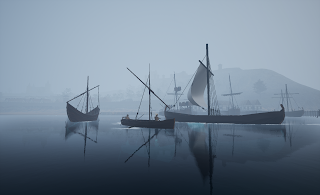Coble: Port of Scarborough 1264
Coble (forward center) with a Yenikapi (left) and Knarr (right)
From time immemorial, the Five Man Boat or Coble, has fished for soles, brill, turbot, crabs and crayfish off the North Yorkshire coast. The number of Cobel has varied over time - from 5 to 30+ (the port still records a couple of dozen Cobels).
A century ago, Hinderwell, a local Scarborough historian, criticized the initiative of the local fishermen, who were content to fish according to the old ways. Hinderwell claimed that with more effort and nets, they would surely catch more and the town would prosper. We now know how over-fishing works out; the Cobel fishers knew a little more than the historian.
Hinderwell was wrong on another account. Cobel fishing involves a great deal of intellectual and physical effort. Knowledge of the tides and the habits of fish only comes with a lifetime of observation and experience. The physical effort involved in the enterprise is demanding and involved the entire fishing family. Cobel fishers use long lines with multiple hooks. Each boat took five lines. The lines needed to be coiled and baited before the fleet departed.
The coastal fish bite according to the position of the moon (directly overhead or 180 degrees from overhead) and/or the start of the rise or fall of the tide. On calm days (1 in 3), distant pools were farmed, with the boats leaving according to an expected arrival. On overcast days (1 in 3) the boat would fan out along the nearby coast. On rain drench or stormy days, the boats would be drawn higher on the beaches. As the difference between spring and neap (the high and low tides) is up to 5m, floating or beaching a boat could involve a long drag as the south sands shores can become quite expansive.
Mussels were used to bait the lines - and these need to be collected from nearby rivers (and stored in tidal pools marked by rocks). When the fleet returned, the catch needed to be cleaned. They were sold at a beach market (fish vendors were not permitted inside the town walls), before the process of coiling and rebaiting the lines began anew.
The Cobel works comfortably off a beach, capable of being drawn up the sands to avoid high tide or storms, on a simple set of wheels. I wonder how these local fishers felt about the new port, and the new taxes that came with them. Perhaps the cobel fishers left the port and its taxes to the larger herring boats - and continued to launch their boats from the beach.












Comments